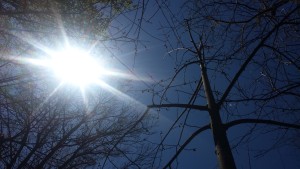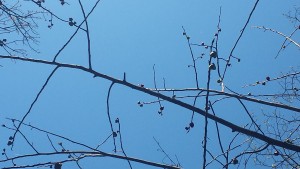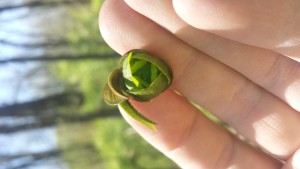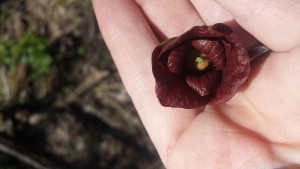Growing up, cooler temperatures and changing colors signified two things: fall camping, and pawpaw season. My dad and I knew of a well-kept secret grove of mature trees just a short hike from our house. I remember shaking the trees one by one and collecting bag after bag of the plump, sweet-smelling green fruits. We gave them away to family members, eat as much as we could stand, and still had plenty to experiment with recipes for pawpaw cream pie and pawpaw bread. (For the record, the pie was AWFUL. I plan on working on it again soon.)
It’s been years many years since that particular grove was bulldozed to make room for high-income condos, and I have not had a pawpaw in quite some time. I was still surprised, however, while talking with people in college, even professors, when they asked “what’s a pawpaw?” What is a pawpaw!? It’s North America’s largest native edible fruit! I find it amazing that we are so familiar with bananas, avocados, mangoes, and pomegranates, but not the fruits native to where we live.
Pawpaws
A pawpaw is often also called a custard apple, due to its texture. It is silky like an avocado, and tastes like a cross between banana, papaya, and mango. It is also extremely healthy, containing all the essential amino acids, lots of Vitamin C, and potassium. The only downside is that it has a very short shelf life. When we get fruit, we intend to explore different ways to preserve them, possibly including pawpaw wine, in addition to desserts and freezer jams. I have not yet found a guaranteed safe-to-can recipe for pawpaws.
We have many mature pawpaw trees on our property, but did not actually get any fruit this year. This may be due to a lack of pollinators or different cultivars. Though many people hand pollinate, we are trying to avoid this, as our trees are quite tall. They flower in spring, so we may be able to find some answers then. Pawpaw flowers smell slightly putrid and are dark red, resembling meat. This is to attract their rather unconventional pollinators: blow flies, flesh flies, and marsh flies, and possibly other carrion insects. Many people swear by hanging meat or road kill in the trees to attract these flies, though there is no clear evidence this is necessary.
Pawpaws do develop root suckers, so a whole grove can actually be one connected organism. Since most seem to be self-incompatible, this may be another reason we had no fruit this year. I hope by opening up the canopy and strengthening the stands, as well as adding genetic variety, we can increase fruit set without hand pollination or use of meat. We planted six seedling pawpaws of two different varieties this winter: “Eastern Seedling” and “Collin’s Select”. Though it will be many years before they reach maturity, I hope they will increase the genetic variety of our groves in the future.
Persimmons
Persimmon is another delectable native tree fruit that many are not familiar with. We found a mature persimmon patch, along with 2 groupings of pawpaws that are growing on our farm. Persimmons are a small, cherry-tomato sized orange fruit that tastes, to me, like an apricot. Unripe, they taste like the driest thing you’ve ever put in your mouth. Until they are squishy and look almost like they’re going bad, they are very astringent. But don’t let that scare you off, they are awesome. You can harvest these in September also, and do many things with the pulp. We like to separate the seeds and skin from the pulp and freeze it for later use in breads, desserts, and freezer jams. Ice cube trays work very well for freezing in small portions.
Some very helpful links about these great fruit trees and resources for my research are below, check them out!
Pawpaws:
pawpaw.kysu.edu/pawpaw/cooking.htm – Nutritional information
pubs.ext.vt.edu/438/438-105/438-105.html
apiosinstitute.org/asimina-triloba-pawpaw#comment-596 – Information on hand-pollination
ohiopawpaw.com/Handling.pdf – Handeling processing & Freezing Pawpaw
southcenters.osu.edu/sites/southc/files/site-library/site-documents/HORT/Fruits/pawpaws/PawpawProcessing.pdf – Modified mill for pawpaw processing
Persimmons:
crfg.org/pubs/ff/persimmon.html
food-skills-for-self-sufficiency.com/persimmons.html – A wonderful link about harvesting and processing persimmons. Special thanks to Jeff for sharing his persimmon pudding recipe with us!
epersimmons.com/recipes.htm – Many recipes you can try with persimmon pulp. Again, the jury is still out on if persimmon is safe to waterbath can, I do not recommend anything other than freezer jam with them.
vegitationagitation.blogspot.com/2011/12/persimmon-fruit-leather.html – A very creative way to use up any leftover pulp: fruit leather!




